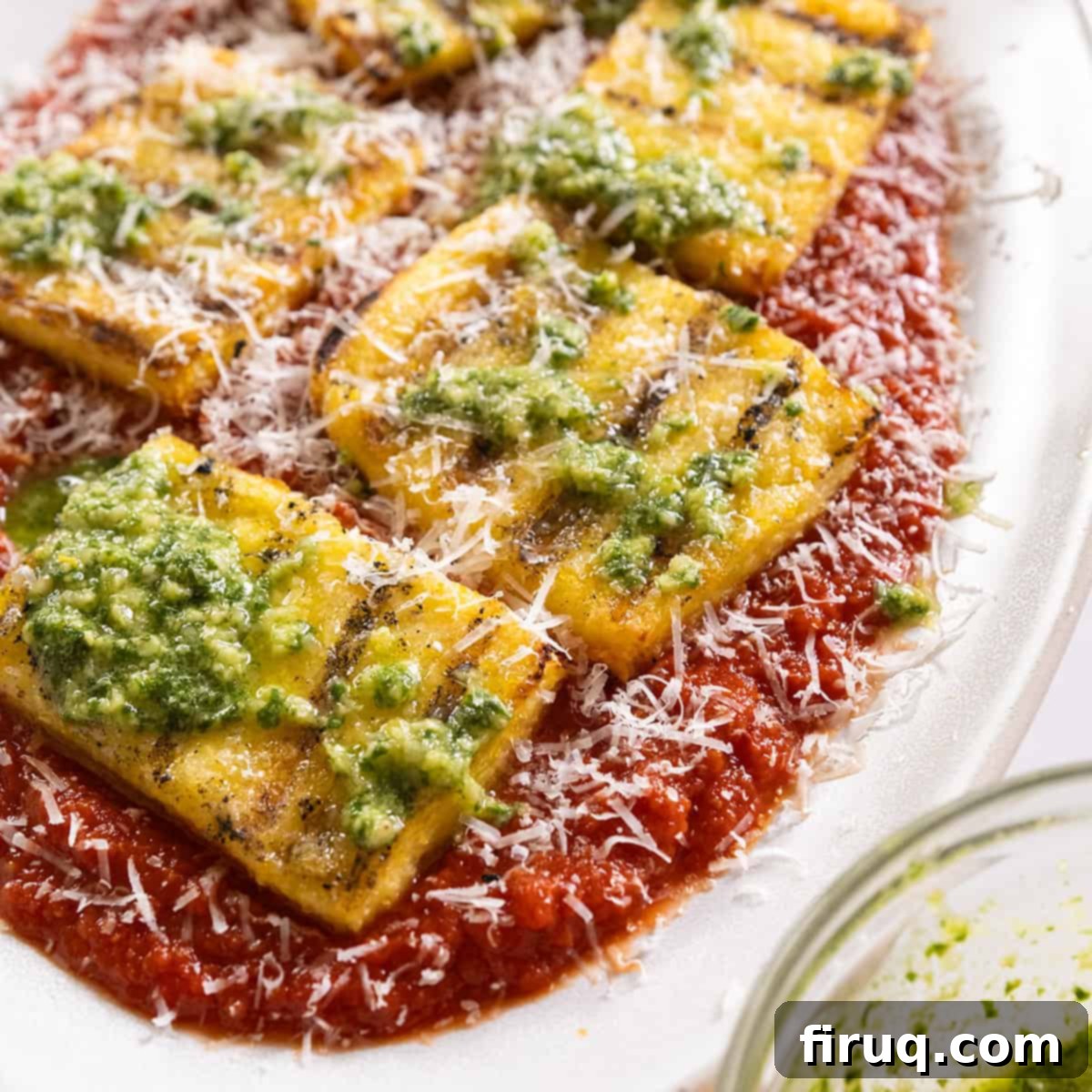Crispy Grilled Polenta with Marinara & Pesto: Your Ultimate Italian Side Dish Guide
Discover the delightful simplicity of **Crispy Grilled Polenta over rich Marinara with vibrant Pesto** – an exquisitely flavorful and perfectly crispy side dish that elevates any grilled meal. This classic Italian creation is not only a fantastic accompaniment to your favorite barbecue recipes but also shines as an impressive appetizer for any gathering. Its golden exterior and tender interior, bathed in savory marinara and bright pesto, promise a culinary experience that’s both comforting and gourmet.
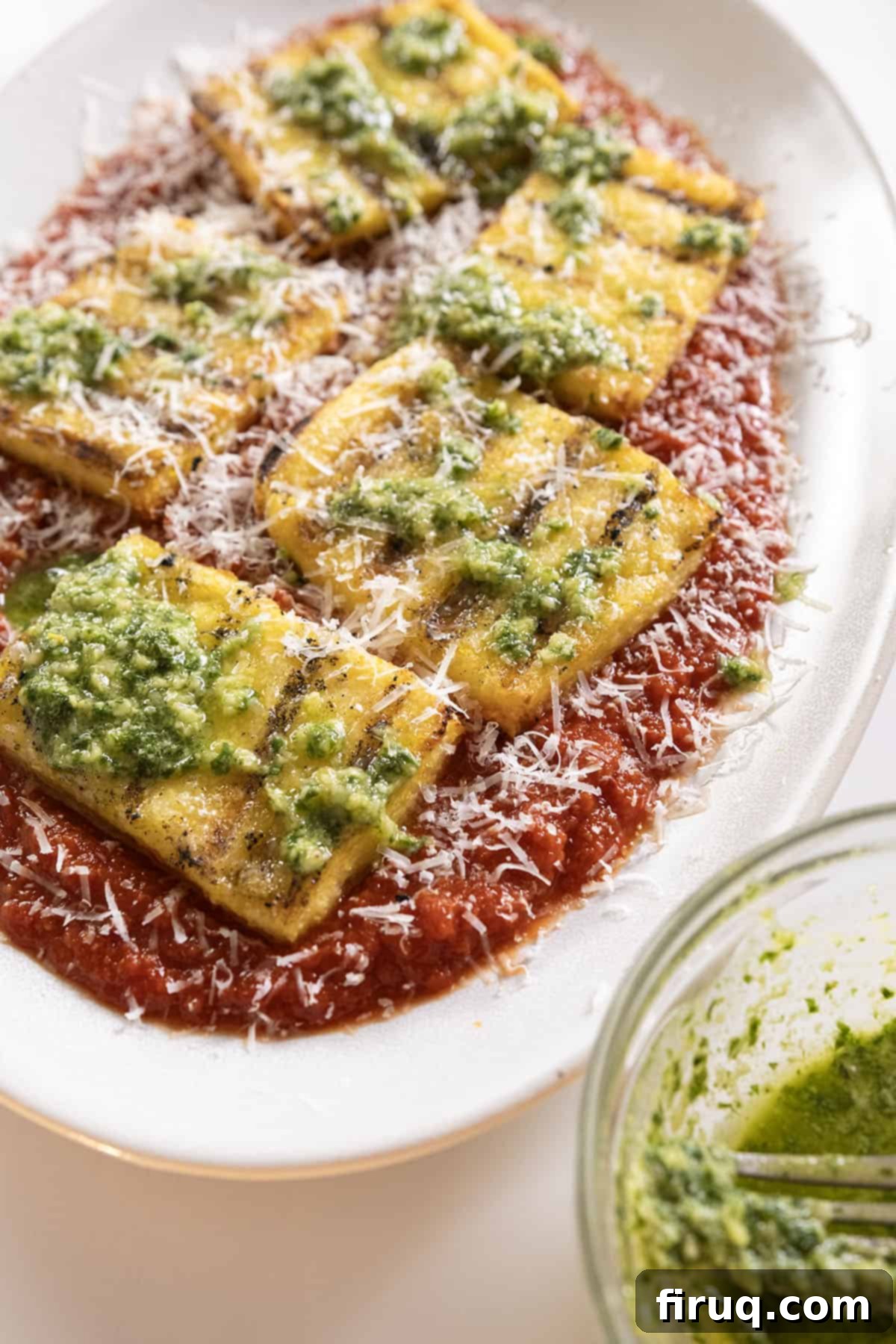
For more incredible grilling side dishes that complement the vibrant flavors of summer, make sure to explore our delightful **Chickpea Cucumber Feta Salad** or the refreshing **Summer Farro Salad with Cannellini Beans**. These recipes perfectly pair with grilled polenta for a complete and satisfying meal.
Why You’ll Love This Grilled Polenta Recipe
Many home cooks might shy away from polenta, but it’s truly one of the most versatile and rewarding ingredients to work with. It transforms into a comforting creamy dish, and its grilled version offers a unique texture and flavor profile that makes it an excellent appetizer or a hearty side. Here are compelling reasons why this **Crispy Grilled Polenta recipe** deserves a spot in your culinary repertoire:
- **Effortless & Clean Grilling**: Forget the mess and splatter of pan-frying! Grilling polenta is remarkably easier and cleaner. Unlike fried polenta, which often leaves oil splatters on your stove and clothes (a common kitchen mishap I know all too well!), grilling offers a hands-off approach with minimal cleanup, allowing you to enjoy the process and the meal without the fuss.
- **Maximize Leftovers, Minimize Waste**: This recipe is a fantastic way to give leftover **creamy polenta** a second life. By preparing a larger batch of creamy polenta, you get to enjoy two distinct, delicious meals from one initial effort. Simply chill the excess, and you’re halfway to a sensational grilled dish, transforming soft comfort food into a crispy delight.
- **The Perfect Companion**: Grilled polenta is an incredibly versatile side that pairs beautifully with a wide array of Italian main courses. Imagine serving these crispy polenta slices alongside robust **Classic Italian Fried Meatballs**, or as a bed for rich, slow-simmered sauces like your leftover **Authentic Italian Sunday Sauce** or a hearty **Authentic Bolognese**. Its neutral yet satisfying flavor perfectly absorbs the nuances of accompanying sauces.
Essential Ingredients & Smart Substitutions for Grilled Polenta
Crafting perfect grilled polenta starts with understanding your ingredients. While the list is simple, the quality and type of each component significantly impact the final flavor and texture of your crispy polenta. Here’s a detailed look at what you’ll need and how to make smart substitutions:
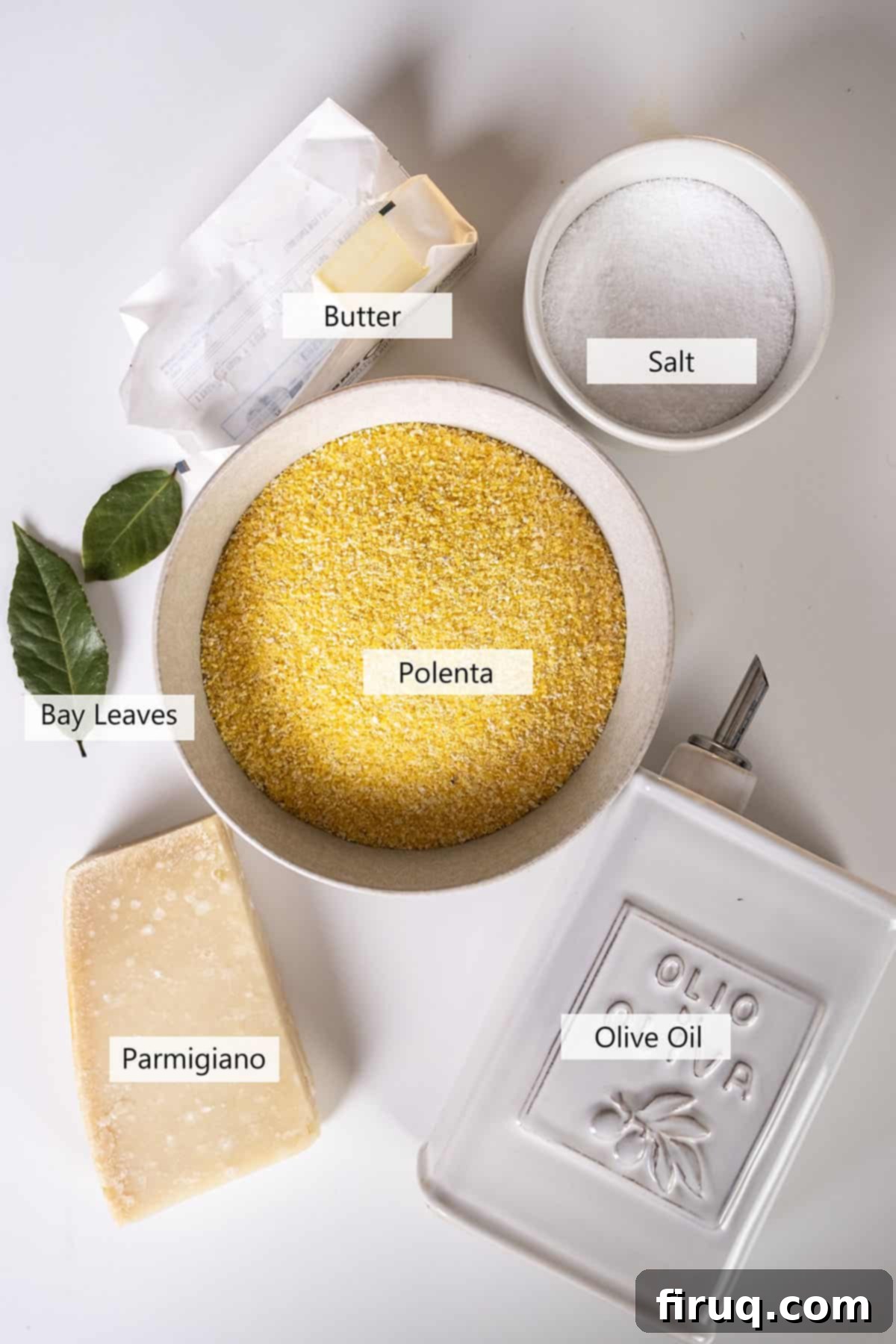
- **Polenta (Medium Grit Cornmeal)**: This is the star of our dish. Opt for a medium-grit cornmeal for the best texture in your grilled polenta. It provides a satisfying chewiness and holds its shape wonderfully when chilled and grilled. Instant polenta can be used for speed, but the texture won’t be as authentic. **Important Note**: Grits are not an appropriate substitute for polenta. While both are made from corn, their processing and starch content differ significantly, leading to vastly different culinary results.
- **Parmigiano Reggiano**: This hard, salty cheese contributes a depth of umami and a smooth, nutty flavor to the polenta. Freshly grated Parmigiano is always preferred for its superior taste and aroma. For a bolder, sharper taste, you can absolutely substitute with Pecorino Romano cheese. It will lend a more assertive, salty kick to your polenta.
- **Extra Virgin Olive Oil**: The quality of your olive oil truly matters here. Use a high-quality extra virgin olive oil not only for cooking the creamy polenta but also for brushing the pre-grilled slices. A good olive oil will impart a fruity, peppery note that beautifully complements the cornmeal and the richness of the butter and cheese.
- **Unsalted Butter**: Butter adds incredible richness and a velvety mouthfeel to the creamy polenta before it’s chilled. Using unsalted butter allows you to control the overall saltiness of the dish. You can use anywhere from a few tablespoons up to a full stick, depending on how rich you desire your polenta to be. Think of it like a risotto – the butter emulsifies with the cornmeal, adding significant depth and luxury. Just as in a **Mushroom Truffle Risotto**, butter is key to achieving that perfect, creamy consistency and rich flavor.
- **Marinara Sauce**: For serving, a good marinara is essential. You can use your favorite high-quality store-bought brand or, for an truly authentic Italian experience, follow our **Ultimate Guide to Marinara Sauce** to make it from scratch. The fresh, tangy sweetness of a homemade marinara will elevate your grilled polenta immensely.
- **Pesto**: The bright, herbaceous notes of pesto cut through the richness of the polenta and marinara, adding a fantastic layer of flavor. While store-bought pesto is convenient, a fresh, homemade pesto makes an undeniable difference. Our **Pistachio Pesto** is incredibly easy to prepare and offers a unique, delicious twist that pairs wonderfully with this dish.
*Please refer to the detailed recipe card below for precise measurements and quantities for all ingredients.
Step-by-Step Guide to Making Perfect Crispy Grilled Polenta
Achieving perfectly crispy grilled polenta begins with a well-prepared creamy base. This recipe streamlines the process, utilizing a chilled, set polenta for grilling ease. While we provide basic instructions here, for a more comprehensive, in-depth guide on making the initial creamy polenta, please consult our dedicated **easy creamy polenta recipe**.
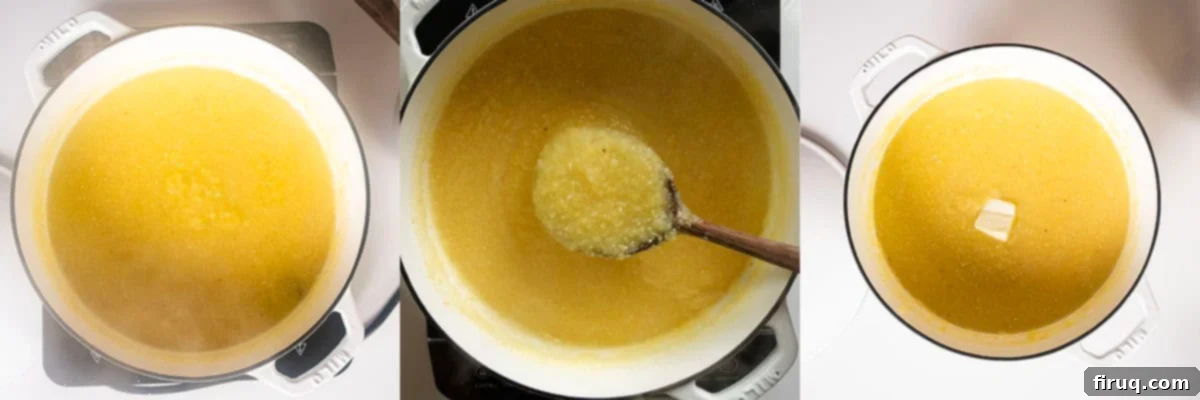
Step 1: Prepare the Creamy Polenta Base
In a large, heavy-bottomed pot or Dutch oven, combine the specified amount of water, a splash of olive oil, bay leaves, and salt. While the water is still cold, slowly whisk in the medium-grit polenta in a thin, steady stream. This technique helps prevent lumps. Increase the heat to medium and bring the mixture to a gentle simmer, then reduce the heat to maintain a steady simmer for about 30 minutes, stirring frequently to prevent sticking and ensure even cooking. The polenta will thicken considerably.
Step 2: Finish and Chill the Polenta
Once the polenta is thick and creamy, remove it from the heat. Stir in the butter and grated Parmigiano cheese until they are fully incorporated and melted, creating a rich and smooth consistency. Immediately pour the hot polenta into a lightly greased baking pan, spreading it evenly. Cover the pan with plastic wrap, pressing it directly onto the surface of the polenta to prevent a skin from forming. Refrigerate for at least 4 hours, or ideally, overnight, until it is completely firm and set.
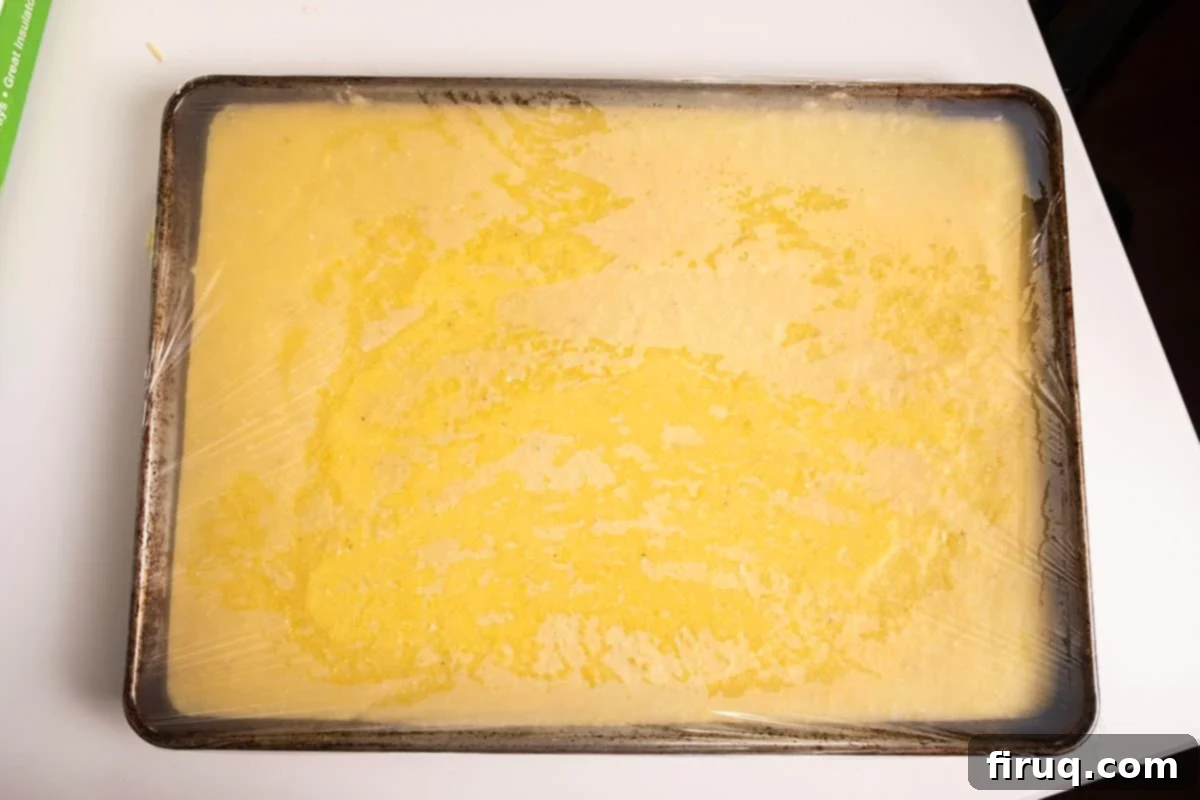
Step 3: Cut and Prepare for Grilling
Once thoroughly chilled, the polenta will have a firm, somewhat rubbery texture, making it easy to handle. Preheat your grill to a medium heat. Carefully remove the solidified polenta from the baking pan. Using a sharp knife, cut the polenta sheet into your desired shapes – squares, rectangles, or triangles work well. Arrange the cut polenta pieces on a plate or tray and lightly brush both sides of each piece with a good quality extra virgin olive oil. This not only prevents sticking but also helps achieve that desirable golden crispness and enhances flavor.
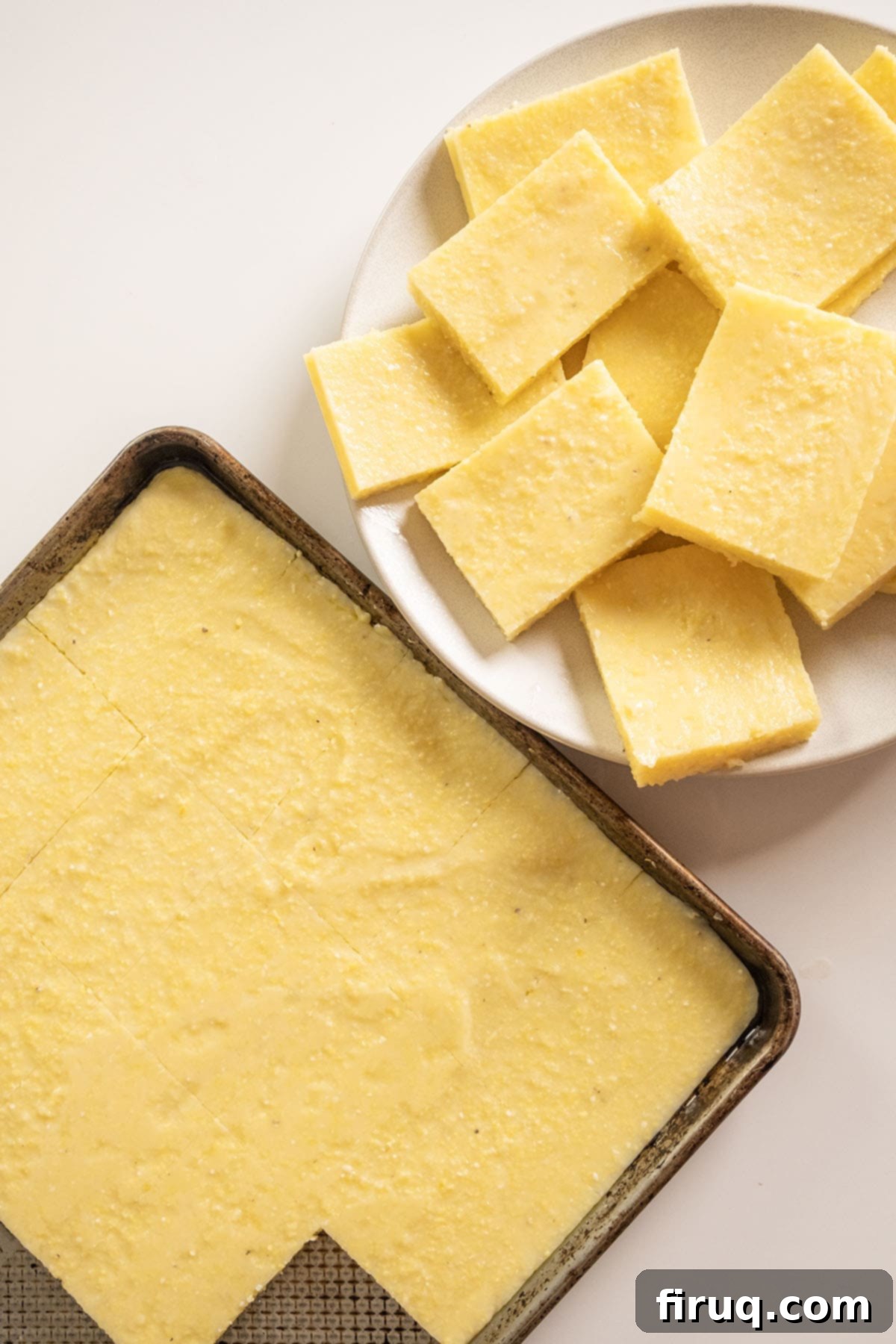
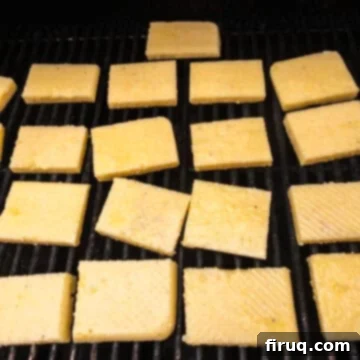
Step 4: Grill to Crispy Perfection
Place the oiled polenta pieces directly onto the preheated grill grates. Grill each side for 5-6 minutes. The key is to wait until the polenta easily releases from the grates. If it’s sticking, it means it hasn’t developed a sufficient crust yet. Resist the urge to scrape or force it; patience is vital here for achieving those beautiful, distinct grill marks and a perfectly crispy exterior.
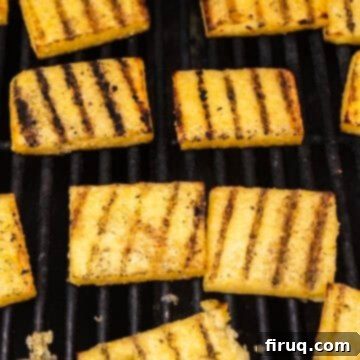
Step 5: Master the Grill Marks
The tell-tale sign of perfectly grilled polenta are those distinct, golden-brown grill marks. As mentioned, if the polenta is sticking to the grates, it simply isn’t ready to be flipped yet. Allow it to cook for a little longer, and it will naturally unstick when the crust has fully formed. This patience ensures a beautiful presentation and that satisfying crispy texture.
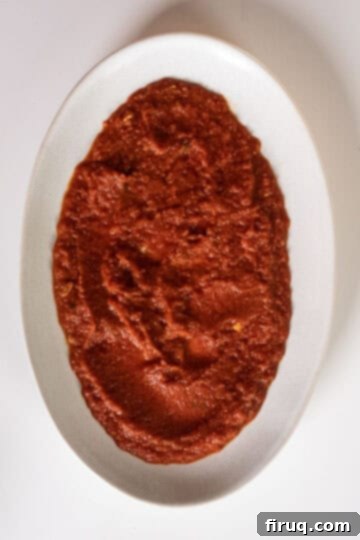
Step 6: Prepare Your Serving Plate
While your polenta is grilling, warm your favorite marinara sauce. Generously cover the bottom of your serving plate with this rich, flavorful sauce. The quality of the marinara is crucial here; it will be the savory foundation for your crispy polenta. Feel free to use a high-quality store-bought option, or for a truly authentic taste, refer to our comprehensive Guide to Marinara Sauce.
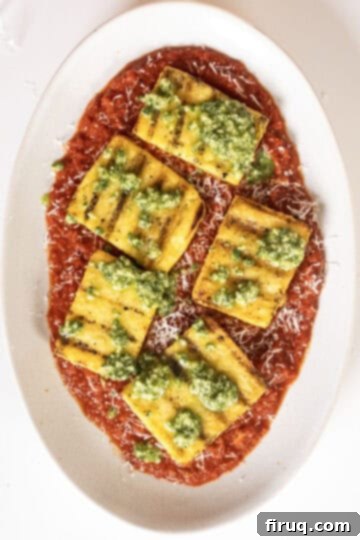
Step 7: Assemble and Serve
Carefully arrange the freshly grilled polenta pieces over the marinara sauce. Drizzle generously with fresh pesto – while store-bought works, homemade makes a world of difference for this recipe. Our Pistachio Pesto is a highly recommended and easy option that adds a unique twist. Finish with an extra flourish of grated Parmigiano cheese. Serve immediately and enjoy this incredible blend of textures and classic Italian flavors.
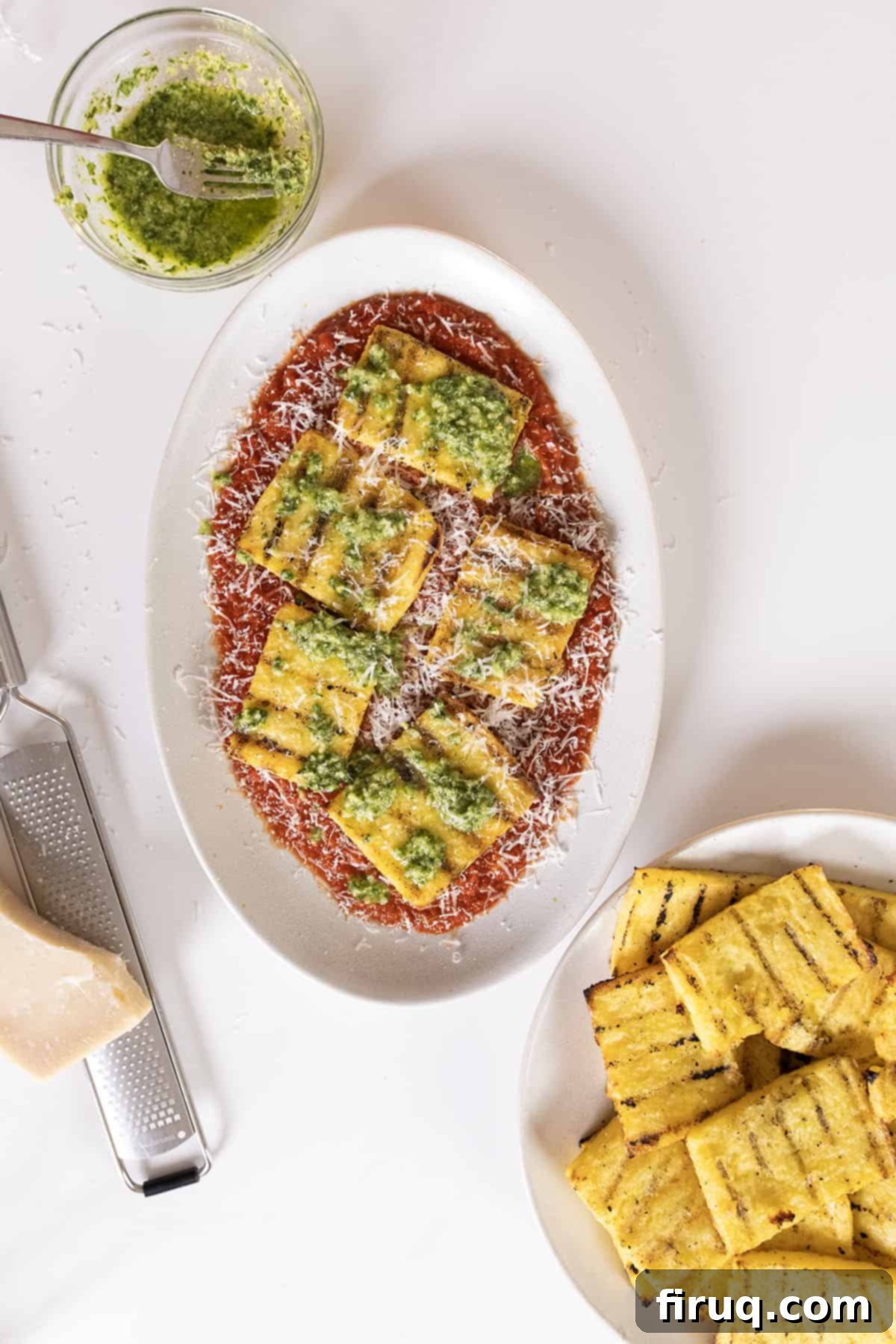
This classic Italian dish is one of my personal favorites to introduce to those who have yet to experience its magic. The combination of crispy polenta, rich marinara, and fragrant pesto is surprisingly delicious and often becomes an instant hit. During the summer months, I particularly love serving it alongside other grilled delights like flavorful **Chicken Spiedini** or succulent **Garlic Parm Chicken Skewers**. It’s truly a versatile and crowd-pleasing addition to any meal.
Pro-Tips for Perfectly Grilled Polenta
Mastering grilled polenta is easy with a few insider tips. Follow these recommendations to ensure your polenta turns out crispy, flavorful, and perfectly cooked every time:
- **Crucial Chilling Time**: The absolute most important step is to **chill the creamy polenta for at least 4 hours**, or preferably overnight. If the polenta is not fully set and firm, it will be too soft and will inevitably fall through the grill grates. This chilling period allows the polenta to firm up, making it structurally sound for grilling.
- **Patience is Key on the Grill**: When grilling, **do not attempt to scrape the polenta off the grill grates if it is sticking**. This is a common mistake. If it’s sticking, it simply means the crust hasn’t fully developed yet. Allow it more time to cook on that side. The polenta will naturally release from the grates when it has formed a crispy, golden-brown crust and is ready to be flipped.
- **Best Reheating Method**: For any leftover grilled polenta, the ideal way to reheat it is to **place it back on the grill** or in a hot pan. This method helps to reactivate the crispy exterior, ensuring it regains its desirable texture, unlike microwave reheating which can make it soft.
- **Optimal Grill Temperature**: Maintain a consistent medium heat on your grill. Too high, and the polenta might char too quickly before the inside warms through; too low, and you won’t achieve that beautiful crispness and grill marks.
- **Slice Consistency**: Cut your polenta slices to a consistent thickness, around ½ to ¾ inch. This ensures even cooking and uniform crispness across all pieces.
- **Flavored Oils**: Consider infusing your olive oil with a garlic clove or a sprig of rosemary before brushing it on the polenta for an extra layer of aromatic flavor.
Grilled Polenta Recipe FAQs
While both polenta and grits are made from ground cornmeal, they are not interchangeable. Polenta typically uses a specific type of yellow corn and can vary in grind size, while grits are usually made from white hominy corn (alkali-treated) and have a finer, starchier texture. Substituting one for the other will result in a different texture and flavor profile.
Absolutely! Using pre-cooked polenta from a tube is a fantastic shortcut for this recipe. It’s as easy as slicing the polenta into your desired shapes, lightly brushing with olive oil, and then grilling. This saves you the initial step of cooking and chilling your own creamy polenta, making the process even quicker and more convenient.
If your polenta is sticking to the grill, it means it’s not ready to be flipped or removed yet. Resist the urge to force it off. Let it continue cooking for another minute or two. The polenta will naturally release from the grill grates once a sufficient crispy crust has formed, so patience is key for those perfect grill marks and easy flipping.
To achieve maximum crispness, ensure your polenta is thoroughly chilled and firm before grilling. Don’t overcrowd the grill, allowing enough space for even heat distribution. Brushing both sides generously with olive oil also aids in crisping. And, as always, resist flipping until it naturally releases from the grates, indicating a well-formed crust.
Beyond marinara and pesto, grilled polenta is incredibly versatile! You can top it with roasted vegetables, sautéed mushrooms, a sprinkle of fresh herbs like basil or oregano, crumbled feta or goat cheese, or even a dollop of fresh ricotta. For a decadent touch, a drizzle of balsamic glaze or a sprinkle of chili flakes can also elevate the flavors.
More Delicious Grilled Recipes to Try
If you love the smoky flavor and ease of grilling, here are a few more fantastic recipes that will perfectly complement your crispy grilled polenta or stand alone as a delicious meal:
- Grilled Stuffed Pork Chops
- Gorgonzola Grilled Chicken Burger
- Italian Sausage and Peppers
- Italian Ring Sausage (Chevalatta)
We hope you thoroughly enjoy creating and savoring this incredible grilled polenta recipe. Your feedback is invaluable to us, so please **leave a comment** and a **star rating** below in the recipe card after you’ve tried it! We love hearing what you think of our recipes. Don’t forget to tag us on Instagram @vindelgiudice when you share your delicious creations!
📖 Recipe
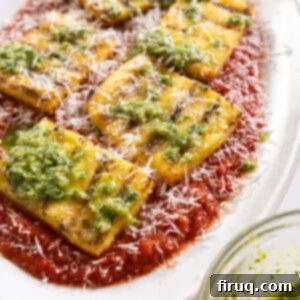
Crispy Grilled Polenta with Marinara and Pesto
Vincent DelGiudiceEquipment
- 1 Large Dutch Oven or Pot
- 1 large baking tray
- 1 grill
Ingredients
- 2 cups medium grit cornmeal or polenta
- 10 cups water
- 2 cups Parmigiano cheese
- 1 teaspoon salt
- ¼ cup extra virgin olive oil
- 2 bay leaves
- 1 stick unsalted butter
For Grilling/ Serving
- 2 cups Marinara sauce
- ½ cup fresh pesto
- 2 tablespoon extra virgin olive oil
- ¼ cup freshly grated Parmigiano cheese
Instructions
-
In a large pot, combine water, olive oil, bay leaves, and salt. While cold, slowly whisk in the polenta in a thin stream to prevent lumps. Bring to a medium simmer and cook for 30 minutes, stirring frequently to prevent sticking and achieve a creamy consistency.
-
Remove the pot from the heat and stir in the butter and Parmigiano cheese until thoroughly combined and melted. While still hot, pour the creamy polenta into a greased baking pan, spreading it evenly. Cover tightly with plastic wrap directly on the surface to prevent a skin from forming. Refrigerate for at least 4 hours, or ideally overnight, until completely firm.
-
Preheat your grill to medium heat. Once the polenta is thoroughly chilled and firm (it should feel rubbery), remove it from the pan. Use a sharp knife to cut your desired shapes (squares, rectangles, etc.) from the polenta sheet. Arrange the cut pieces on a plate and lightly brush both sides with extra virgin olive oil.
-
Place the oiled polenta pieces on the preheated grill grates. Grill each side for 5-6 minutes, or until a crispy golden-brown crust forms and the polenta easily releases from the grates. If it’s sticking, it’s not done cooking on that side yet; allow more time.
-
Once grilled, remove the crispy polenta from the grill. Serve immediately over a bed of warm marinara sauce, drizzled with fresh pesto, and garnished with an extra sprinkle of grated Parmigiano cheese. Enjoy!
Notes
- Chill the creamy polenta for at least 4 hours. It will fall right through the grill grates if you don’t chill for long enough. It needs time to set.
- Do not try to scrape the polenta off the grill if it is sticking. If it’s still sticking, it’s not ready to be flipped.
- The best way to reheat is to place it back on the grill or in a hot pan.
